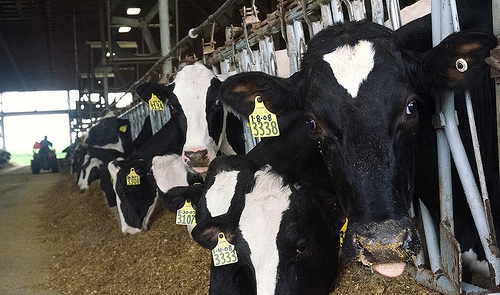
Features
Agronomy
Applications
Dairy
Livestock Production
Manure Application
Manure Management
United States
Devising an effective sampling program for dairy manure
March 29, 2019 by UMass Extension

Manure contains ample amounts of nutrients and is considered to be an integral component of dairy farm nutrient management. Significant amounts of Nitrogen (N), Phosphorus (P), and Potassium (K) as well as small amounts of trace minerals are present in dairy manure and can be utilized as a main source of fertilizer for dairy operations, thereby potentially reducing input costs.
It is important to have an understanding of the nutrient concentrations contained in the manure when planning for land application. An analysis of manure nutrients is required in order to calculate the amount of manure needed to supply enough fertility to support crop growth. Nutrient content will fluctuate depending on the diet and age of the cow, the type and amount of bedding, handling and storage, seasonal precipitation, among other management differences.
For example, the nitrogen content of solid dairy manure may vary from three to 33 lb/ton and the phosphorus content from <1 to 35 lb/ton. In order to account for these differences, annual sampling is highly advised to track nutrient difference and maximize the economic value of manure. Separate, representative manure samples must be collected and analyzed for each form (liquid or solid) of manure applied each year. Devising an effective sampling program must take into account time, method, and frequency of sampling.
When is the best time to sample manure?
Ideally, manure should be sampled during or just prior to hauling for land application. This will provide the most accurate nutrient analysis because the manure has been agitated ensuring a representative sample. However, when sampling during agitation or hauling, the results from the lab analysis will not be sent back in time to include in the current years nutrient management plan, but analysis can be used for planning the following year’s fertility plan, and to adjust additional fertilizer applications.
Take manure samples annually for three years, followed by samples every four to five years. Keep records on file for management references. If storage(s) are emptied twice a year, it is recommended to sample in both spring and fall since the varying storage temperatures in summer compared to winter will affect manure nutrient levels.
Methods of sampling
In general, a composite sample, which is comprised of numerous sub-samples, is needed for every form and site where manure is contained and used as a soil amendment. The more subsamples taken, the more accurate the results will be. Based on your manure management follow these instructions for taking a precise manure sample.
Sampling liquid manure (less than 10 percent solids)
Dairy manure (about 12 percent solid as excreted) is often collected and stored as liquid slurry in earthen, concrete, or steel storage structures. For safety and time appropriateness, it is recommended to sample during application. However, if challenges exist where you are unable to sample at application, then sample with caution from storage facilities such as lagoons due to hazardous gases and the potential for accidents. | For the full article, CLICK HERE.